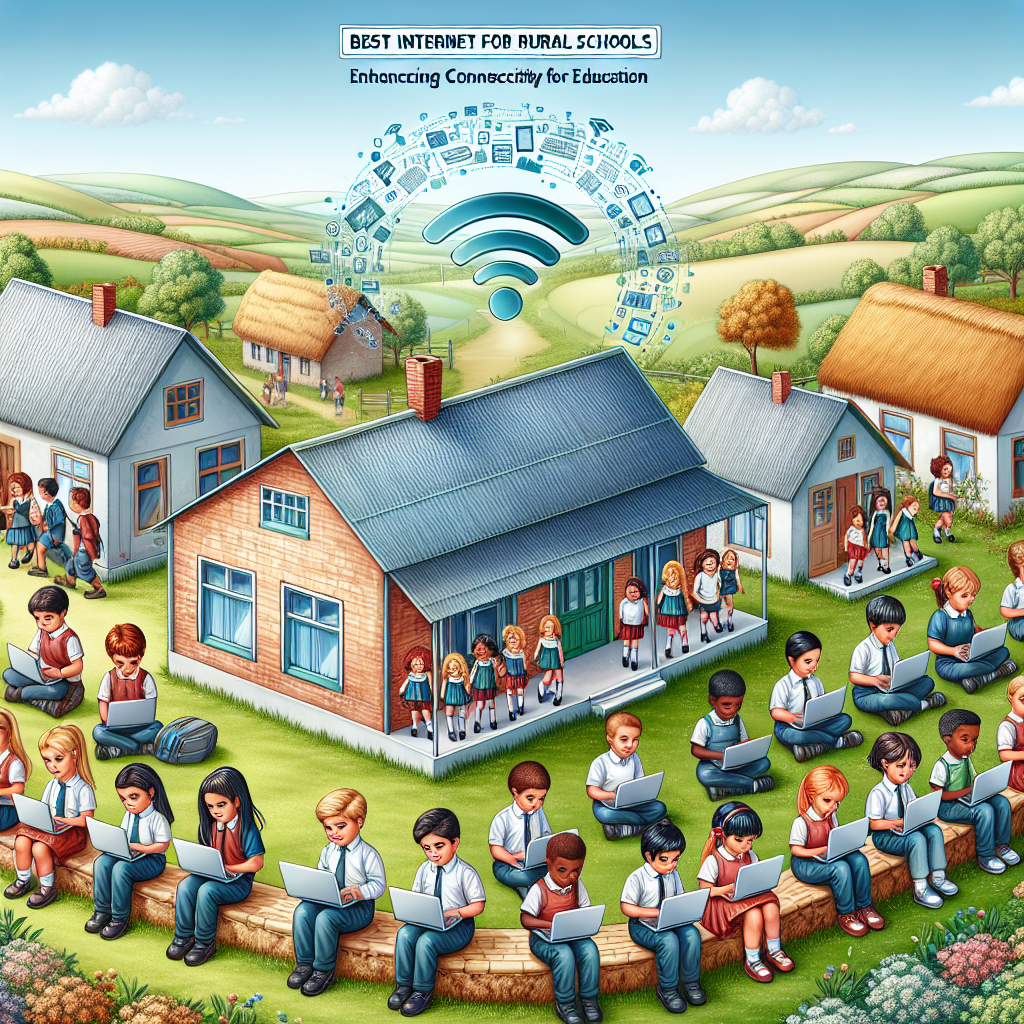In today’s digital age, reliable internet connectivity is essential for the success of rural schools. Access to high-speed internet opens up endless opportunities for students and educators alike, from online research and virtual learning to video conferencing and collaborative projects. However, many rural schools struggle with slow and unreliable internet connections, hindering their ability to provide quality education. In this article, we will explore the importance of having the best internet for rural schools, and how improving connectivity can enhance the learning experience for students and facilitate professional development for teachers. Let’s dive in and discover the power of connectivity in education!
Challenges of Internet Access in Rural Schools

– Limited infrastructure and coverage
Rural schools often face the challenge of limited infrastructure and coverage when it comes to accessing the internet. This is primarily due to the remote locations of these schools, which are far from urban centers where internet infrastructure is more developed. As a result, rural schools may struggle to receive high-speed internet connections, leading to issues with slow loading times and unreliable connectivity.
-
High costs for internet services
Another significant challenge for rural schools is the high costs associated with internet services. Due to the lack of competition in rural areas, internet service providers may charge higher prices for their services, making it difficult for schools with limited budgets to afford reliable internet connections. This financial barrier can hinder access to online resources and educational tools, impacting the overall quality of education provided to students. -
Dependence on satellite internet
Many rural schools rely on satellite internet as their primary source of connectivity. While satellite internet can reach remote locations, it often comes with limitations such as high latency and bandwidth restrictions. This can affect the performance of online learning platforms and video conferencing tools, creating challenges for teachers and students trying to engage in virtual learning activities. -
Impact on educational resources and opportunities
The challenges of internet access in rural schools ultimately have a significant impact on the availability of educational resources and opportunities for students. Limited connectivity can restrict access to online libraries, educational websites, and interactive learning platforms, limiting the ability of teachers to supplement traditional classroom instruction with digital resources. This lack of access can hinder students’ ability to fully engage in online research, collaborative projects, and distance learning programs, reducing their overall educational experience.
Understanding the Importance of Reliable Internet in Rural Schools
In rural areas where access to educational resources may be limited, reliable internet connectivity plays a crucial role in enhancing the overall educational experience for students, teachers, and parents.
-
Facilitating online learning and resources
- Reliable internet enables students in rural schools to access online learning materials, participate in virtual classrooms, and engage in interactive educational platforms. This access to a vast array of resources beyond traditional textbooks enhances their learning experience and provides opportunities for personalized learning.
-
Enhancing communication between teachers, students, and parents
- With reliable internet connectivity, rural schools can improve communication channels between teachers, students, and parents. This facilitates real-time feedback, updates on academic progress, and collaboration on educational goals. Communication through emails, video conferences, and online platforms bridges the gap between school and home, fostering a supportive learning environment.
-
Access to educational tools and platforms
- Reliable internet access allows rural schools to utilize a wide range of educational tools and platforms that enhance teaching methodologies and student engagement. From educational apps to online research databases, students can explore various learning resources that cater to diverse learning styles. Teachers can also access professional development resources and collaborate with peers globally, enriching their teaching practices.
-
Encouraging digital literacy and technology skills
- By providing reliable internet in rural schools, students have the opportunity to develop essential digital literacy and technology skills necessary for the 21st-century workforce. Access to online resources and interactive platforms fosters digital competence, critical thinking, and problem-solving skills. Empowering students with these skills prepares them for future academic and career success in an increasingly digital world.
Types of Internet Options for Rural Schools
Satellite Internet
Types of Internet Options for Rural Schools
Satellite internet is a viable option for enhancing connectivity in rural schools due to its unique advantages and disadvantages.
Advantages:
– Wide coverage in remote areas: Satellite internet can reach even the most isolated rural schools where traditional wired connections are not feasible.
– Availability in various rural locations: It is accessible in diverse geographies, making it a versatile option for schools located in different rural settings.
Disadvantages:
– Latency issues affecting real-time applications: The signal travel distance to and from satellites can result in delays, impacting the performance of real-time applications such as video conferencing or live streaming.
– Data caps and limitations on usage: Satellite internet providers often impose data caps and limitations on usage, which can restrict the amount of data that schools can access within a specific period.
Fixed Wireless Internet
Fixed wireless internet is one of the primary options for enhancing connectivity in rural schools. This technology offers advantages and disadvantages that should be considered when implementing internet solutions for educational purposes.
- Advantages:
- Relatively faster speeds compared to satellite: Fixed wireless internet can provide faster connection speeds compared to satellite internet, allowing for smoother online learning experiences and faster access to educational resources.
-
Lower latency for interactive applications: With lower latency, fixed wireless internet enables real-time communication and interactive educational applications, facilitating seamless virtual classroom experiences for rural students and teachers.
-
Disadvantages:
- Limited coverage in some rural regions: One of the challenges of fixed wireless internet is its limited coverage in certain remote areas. This can restrict access to reliable internet services for schools located in more isolated regions.
- Susceptibility to weather interference: Fixed wireless internet signals can be affected by weather conditions, such as heavy rain or strong winds, leading to potential disruptions in connectivity that may impact online learning activities in rural schools.
DSL and Cable Internet
DSL and cable internet services are common options for providing connectivity to rural schools. Here are some key details to consider:
- Advantages
- Stable and consistent speeds: DSL and cable internet connections typically offer reliable speeds suitable for online learning activities and educational resources.
-
Availability in some rural communities: Many rural areas have access to DSL and cable internet services, making them a feasible option for enhancing connectivity in schools.
-
Disadvantages
- Limited reach in remote areas: One of the main drawbacks of DSL and cable internet is that their coverage may be limited in extremely remote or isolated regions, leaving some rural schools without viable connection options.
- Infrastructure constraints for expansion: Expanding DSL and cable internet infrastructure to reach more rural schools can be challenging and costly, especially in areas where the population density is low and the terrain is rugged.

Factors to Consider in Choosing the Best Internet for Rural Schools
When selecting an internet service provider for rural schools, several crucial factors must be taken into account to ensure that the connectivity meets the educational needs of the institution effectively.
- Reliability:
-
In rural areas, where infrastructure may be less developed, reliability becomes a critical factor in choosing the best internet service for schools. Consistent connectivity is essential for uninterrupted learning, as any downtime can significantly impact educational activities. Schools should prioritize providers with a track record of reliable service to ensure that students and teachers can access online resources without disruptions.
-
Speed:
-
Adequate bandwidth is essential for rural schools to support online activities such as video conferencing, virtual classrooms, and accessing educational resources. Slow internet speeds can hinder the learning experience and limit the potential for interactive online teaching methods. Schools should opt for internet providers that offer sufficient speed to accommodate the needs of both students and educators.
-
Cost:
-
Budget constraints are common in rural school settings, making cost a significant consideration when choosing an internet service provider. Schools must look for budget-friendly options that provide the necessary connectivity without exceeding financial limitations. It is essential to balance cost-effectiveness with the quality of service to ensure that the internet connection meets educational requirements.
-
Scalability:
-
As rural schools grow or expand their online learning initiatives, scalability becomes a crucial factor in selecting an internet service provider. The chosen provider should offer scalable solutions that can accommodate the increasing demands for connectivity as the school expands. Scalability ensures that the internet service can grow alongside the educational institution without requiring frequent upgrades or disruptions.
-
Support:
- Access to reliable customer service and technical support is essential for rural schools, where technical issues may arise due to the remote location or limited IT resources. Schools should prioritize internet providers that offer robust customer support to address any connectivity issues promptly. Having access to technical assistance can help minimize downtime and ensure that the internet connection remains reliable for educational purposes.
Case Studies: Successful Internet Implementation in Rural Schools
In examining successful internet implementation in rural schools, it is crucial to highlight specific examples where connectivity has made a significant impact on education. By delving into case studies of schools that have effectively utilized internet solutions, we can glean valuable insights into best practices and lessons learned.
School A: Overcoming Connectivity Challenges
- Location: School A is situated in a remote rural area with limited infrastructure for internet connectivity.
- Solution: The school partnered with a local internet provider to set up a dedicated broadband connection, ensuring reliable access for both students and teachers.
- Impact: With improved connectivity, School A was able to introduce online learning platforms, virtual classes, and access to educational resources previously unavailable to students. This led to enhanced engagement and academic performance across various subjects.
School B: Leveraging Technology for Learning
- Location: School B is located in a geographically isolated region with minimal access to educational resources.
- Solution: Through a government initiative, School B received funding to implement a satellite internet system, overcoming the limitations of traditional wired connections.
- Impact: The introduction of high-speed internet allowed School B to integrate technology into its curriculum, offering interactive lessons, virtual field trips, and real-time collaboration with experts from around the world. As a result, students demonstrated increased digital literacy and a deeper understanding of global issues.
School C: Community Collaboration for Connectivity
- Location: School C serves a small rural community with limited financial resources for infrastructure development.
- Solution: Recognizing the importance of connectivity, School C collaborated with local businesses and community members to crowdfund the installation of a fiber optic network, ensuring sustainable high-speed internet access.
- Impact: The collective effort to enhance connectivity not only benefited the school but also the broader community. Students at School C were able to access online resources, participate in virtual extracurricular activities, and connect with peers from other schools. This collaborative approach fostered a sense of ownership and pride in the community’s commitment to education.

By examining these case studies and understanding the strategies employed by successful rural schools to enhance connectivity, we can identify key factors that contribute to improved educational outcomes in underserved areas.
Recommendations for Enhancing Internet Access in Rural Schools
In order to improve internet access in rural schools and enhance connectivity for education, several key recommendations can be implemented:
-
Collaborating with government initiatives and providers
-
Rural schools can benefit greatly from collaborating with government initiatives aimed at expanding internet access in underserved areas. By partnering with providers and leveraging government resources, schools can tap into funding opportunities and technical support to improve connectivity.
-
Establishing partnerships with local internet service providers can also lead to more affordable and sustainable solutions for rural schools. By working together, schools and providers can address connectivity challenges more effectively and ensure long-term access to high-speed internet.
-
-
Investing in infrastructure development for underserved areas
-
One of the critical steps in enhancing internet access for rural schools is investing in infrastructure development. This includes expanding broadband networks, upgrading existing infrastructure, and implementing new technologies to bridge the digital divide in remote areas.
-
By prioritizing infrastructure development, schools can create a reliable and robust internet connection that can support online learning, video conferencing, and other educational resources. Investing in infrastructure is essential for ensuring that rural schools have the necessary connectivity to deliver quality education to students.
-
-
Prioritizing digital inclusion and equity in education
-
To enhance internet access in rural schools, it is crucial to prioritize digital inclusion and equity in education. This involves ensuring that all students have equal opportunities to access online resources, participate in virtual classrooms, and engage in digital learning activities.
-
By focusing on digital inclusion, schools can address disparities in internet access among students and promote a more equitable learning environment. This may involve providing devices and internet subsidies to students in need, offering tech support for families, and implementing policies to support students with limited connectivity.
-
-
Empowering educators with training on utilizing online resources
-
Another key recommendation for enhancing internet access in rural schools is to empower educators with training on utilizing online resources. Teachers play a central role in integrating technology into the curriculum and delivering online instruction effectively.
-
By providing professional development opportunities and resources for educators, schools can ensure that teachers are equipped with the skills and knowledge to leverage online platforms, educational apps, and digital tools in their teaching practices. Empowering educators with training can enhance the quality of online education and support student learning in rural schools.
-
FAQs: Best Internet for Rural Schools: Enhancing Connectivity for Education
What are the key factors to consider when choosing the best internet for rural schools?
When choosing the best internet for rural schools, key factors to consider include the availability of high-speed internet options in the area, the reliability of the service provider, the scalability of the internet package to accommodate future growth, and the affordability of the service within the school’s budget constraints.
How can high-speed internet benefit rural schools and enhance connectivity for education?
High-speed internet can benefit rural schools by providing faster and more reliable internet access for students and teachers, enabling them to engage in online learning, access educational resources, collaborate with peers and educators remotely, and participate in virtual classrooms and webinars. This enhanced connectivity can help narrow the digital divide between rural and urban schools and improve overall educational outcomes.
What are some of the challenges faced by rural schools in accessing high-speed internet?
Rural schools often face challenges in accessing high-speed internet due to limited infrastructure in remote areas, higher costs associated with extending internet services to rural locations, and inconsistent internet speeds and connectivity issues. These challenges can hinder the ability of rural schools to fully leverage the benefits of technology in education and provide equitable learning opportunities for all students.
What are some strategies that rural schools can implement to improve their internet connectivity?
Rural schools can implement strategies such as partnering with local internet service providers to expand access to high-speed internet, applying for government grants and funding to support infrastructure development, investing in network upgrades and equipment to improve internet performance, and collaborating with other schools and organizations to share resources and best practices for enhancing internet connectivity in rural areas. By taking these proactive steps, rural schools can overcome the challenges of limited internet access and create a more connected and technologically advanced learning environment for students.


